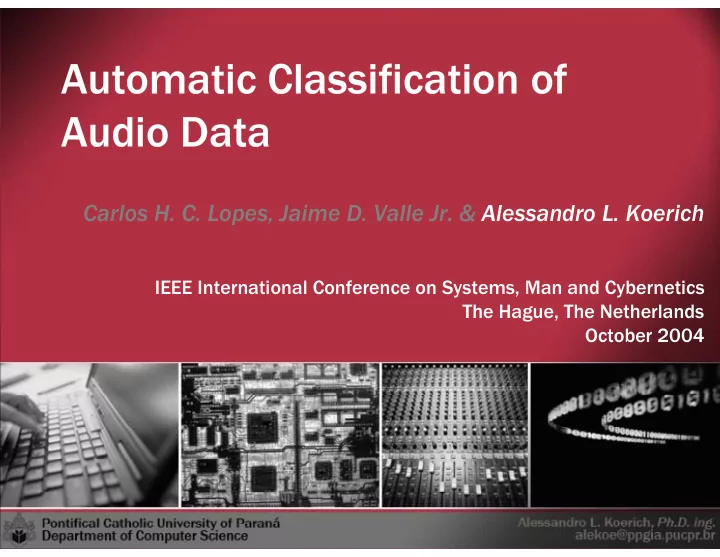

Automatic Classification of Automatic Classification of Audio Data Audio Data Carlos H. C. Lopes, Jaime D. Valle Jr. & Alessandro L. Koerich IEEE International Conference on Systems, Man and Cybernetics The Hague, The Netherlands October 2004
Motivation Motivation • The amount of multimedia now available on–line has created a surge for efficient tools to organize and manage such a huge amount of data. • Digital music is one of the most important data types distributed in the web. • How to effectively organize and process such large variety and quantity of musical data to allow efficient indexing, searching and retrieval is a real challenge.
Motivation Motivation • At present, multimedia data is usually classified based on textual meta–information. • While such information is very useful for indexing, sorting, comparing and retrieval, it is manually generated. • Extracting the information through an automatic and systematic process might overcome such problems.
Motivation Motivation
Proposal Proposal • Musical genre is an important description that has been used to classify and characterize digital music and to organize the large collections available on the web • Musical genres are categorical labels created by humans to characterize music clips. • These characteristics are related to the instrumentation, rhythmic structure, and harmonic content of the music.
Novelty Novelty • A novel approach for content–based musical genre classification based on the combinati mbination of c n of classi assifiers fiers .
Content-Based Approach Content-Based Approach
Content-Based Approach Content-Based Approach
Overview Overview
Feature Extraction ature Extraction • We have considered the problem of content--based musical genre classification as a pattern classification problem. • In such a way → Extract relevant features from music clips • Feature extraction is the process of representing a segment of audio by a compact but descriptive vector.
Feature Extraction ature Extraction • Since digitized music in good sound quality has an 1MB/minute rate, it would be very time consuming to extract the feature vector from the whole music. • In such a way feature extraction is carried out only on segments of the music clip. • Three segments are chosen according to the duration and bit rate of the music.
Feature Extraction ature Extraction
Feature Extraction ature Extraction • The feature set used in this paper was originally proposed by Tzanetakis et al. 2002. • Two different types of features: – musical surface features: mean and average of the spectral centroid, flux, zero--crossing rate, and low energy. – beat--related features: relative amplitudes and beats per minute. • These features form 15--dimensional feature vectors.
Classification Problem Classification Problem • The basic problem in musical genre classification is: • Given a music clip represented by a feature vector X = ( x 1 x 2 ... ... x D ) where D is the dimension of the vector, assign a class, i.e. a musical genre g ∈ G that best matches to the input vector.
Classification Classification • Instance--based method: k--nearest neighbor ( kNN ) algorithm. • A multilayer perceptron (MLP) classifier with one hidden layer trained with the backpropagation algorithm.
Co Combination mbination • The three feature vector are extracted from the same music clip. • The output of the classifiers that take at the input each feature vector can be combined to optimize the classification performance. • We have considered only the majority voting scheme.
Overview Overview
Exp Experimental Results rimental Results • Dataset: 414 music clips (207 rock, 207 classic) – Training set: 208 samples – Validation set: 82 samples – Test set: 122 samples • Three feature vectors were extracted from each music clip → 1,242 feature vectors.
Exp Experimental Results rimental Results
Exp Experimental Results rimental Results
Exp Experimental Results rimental Results
Exp Experimental Results rimental Results
Conclusion Conclusion • Automatic musical genre classification is a difficult pattern recognition task. • We have presented a novel approach to musical genre classification that combines three feature vectors extracted from different regions of music clips. • The feature vectors are combined at classification level through the combination of the outputs of single classifiers.
Conclusion Conclusion • A slight improvement in the correct musical genre classification was achieved. • The combination rule used is very simple. • Future work will include other combination strategies that take into account the confidence scores provided by the classifiers as well as a rejection mechanism to further improve the reliability of the system.
Recommend
More recommend